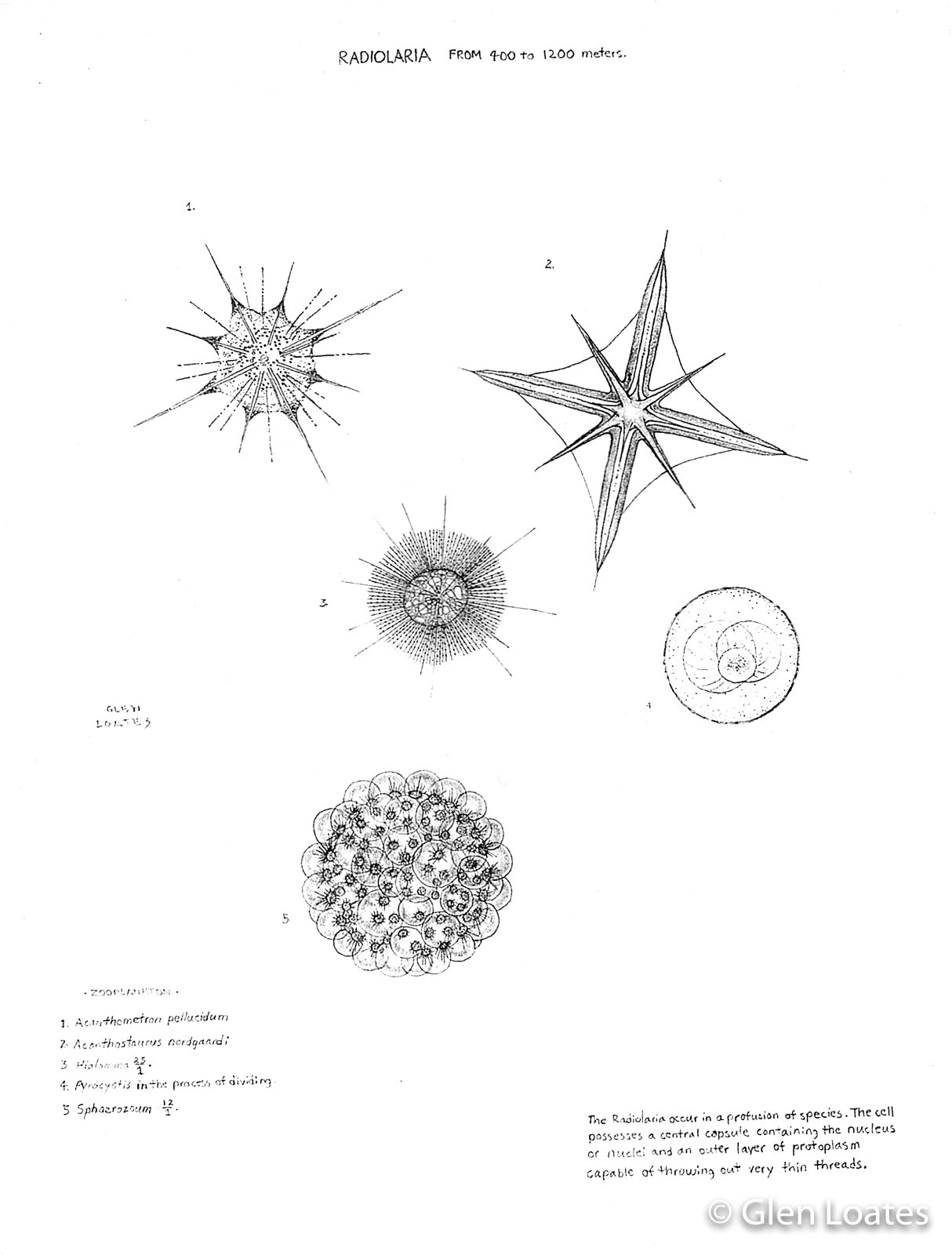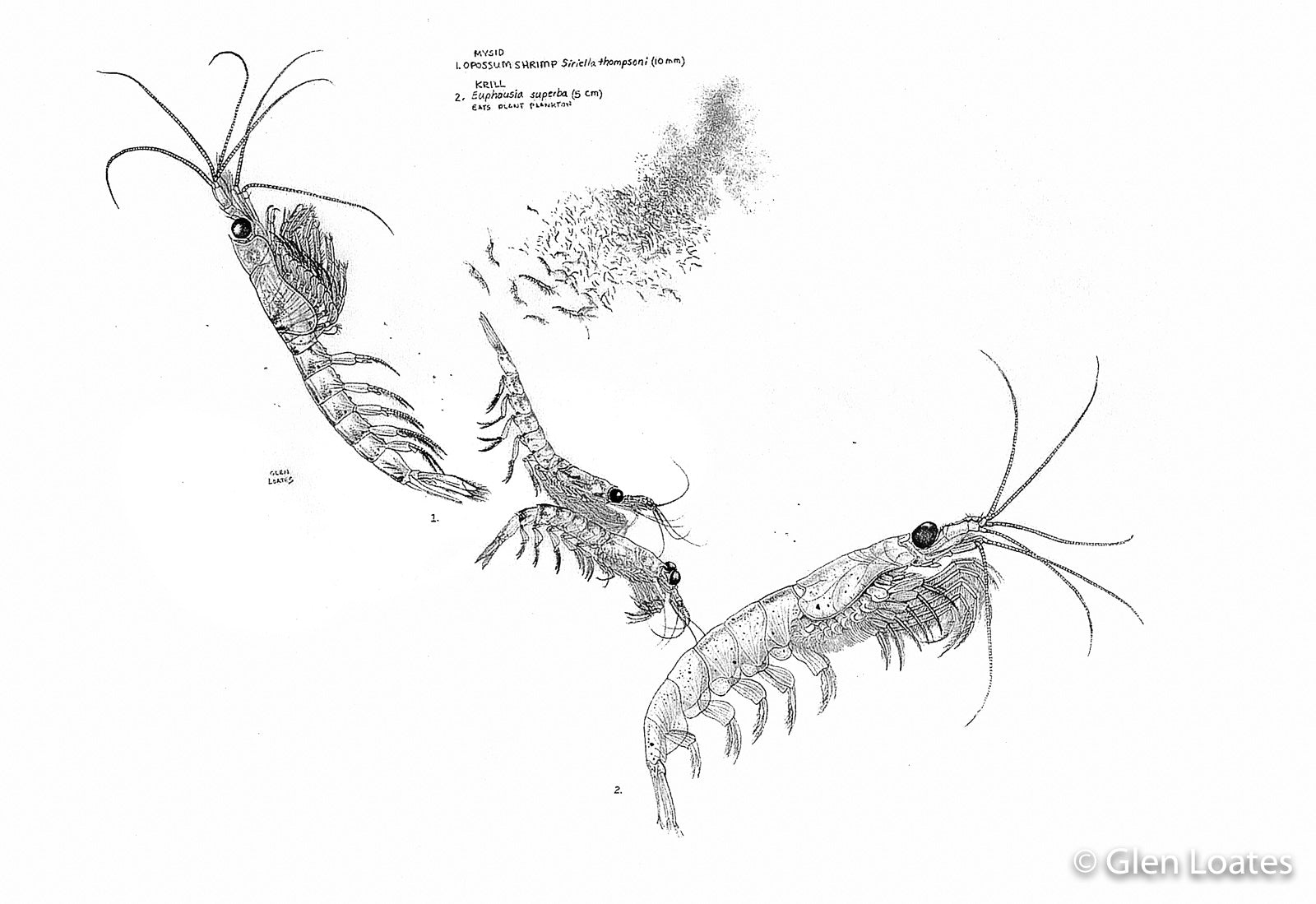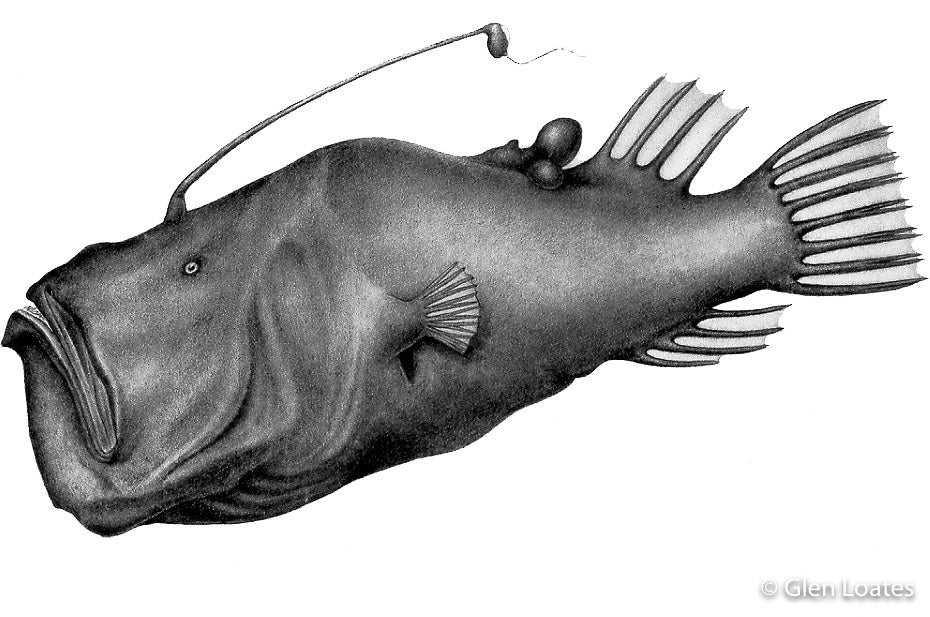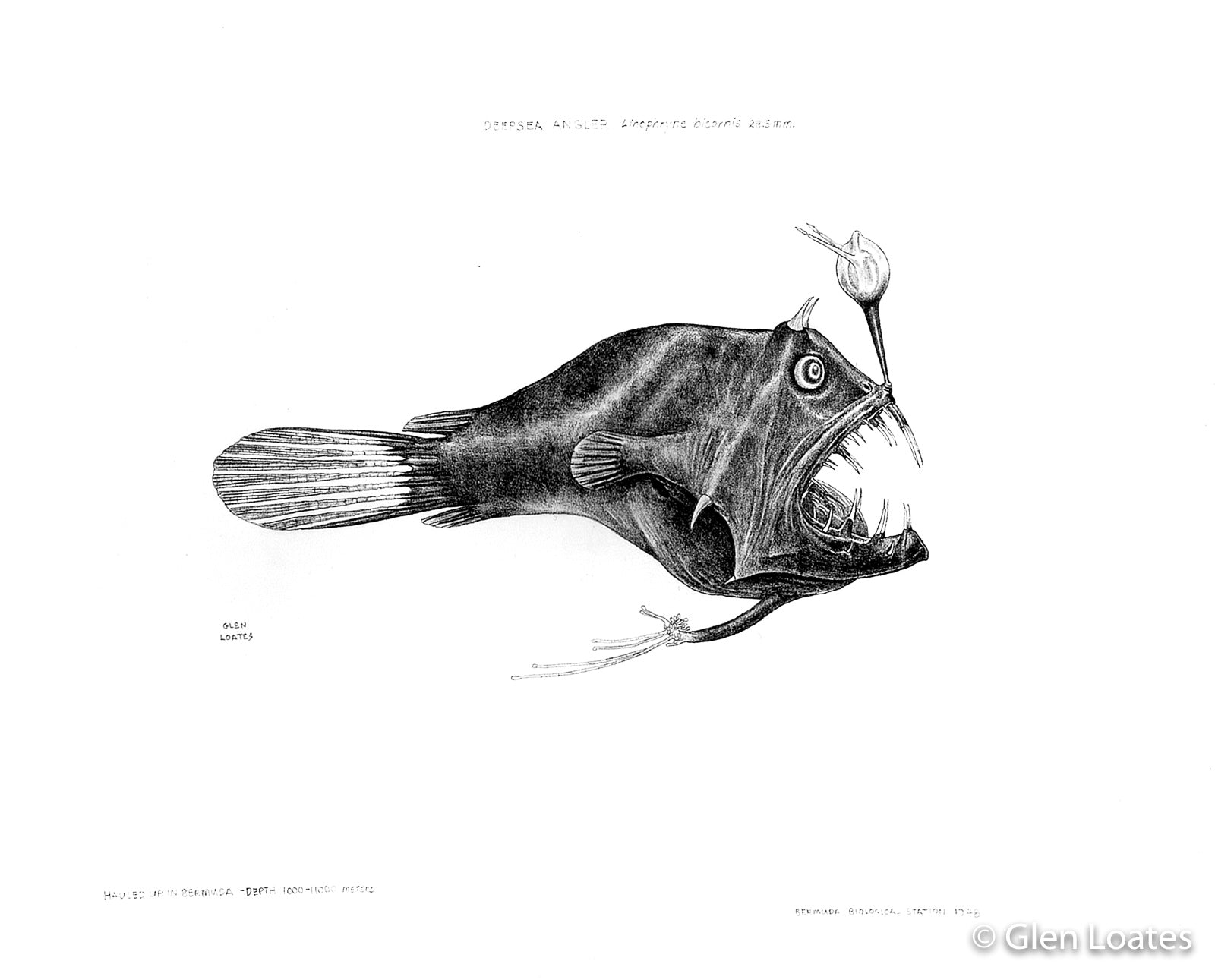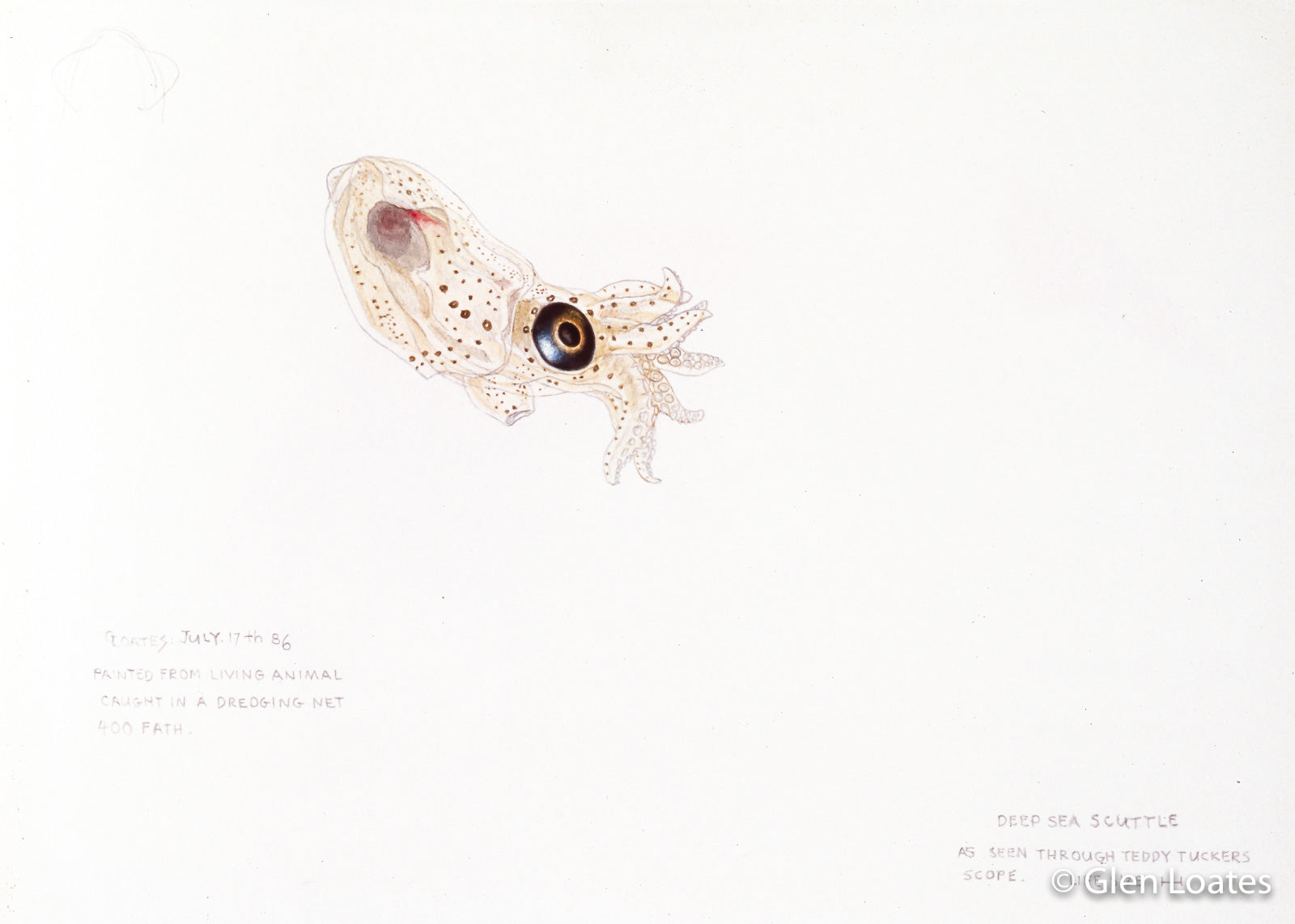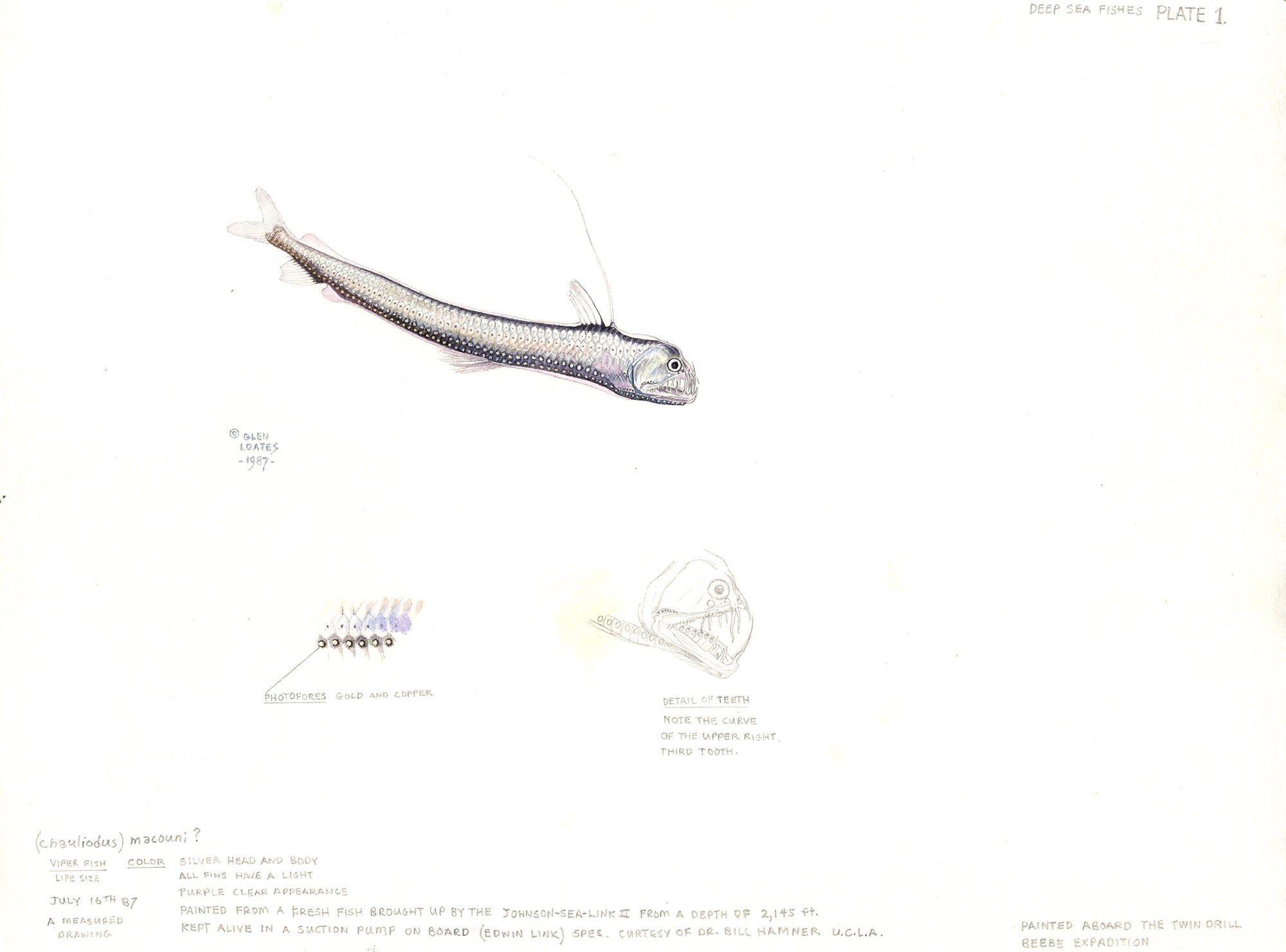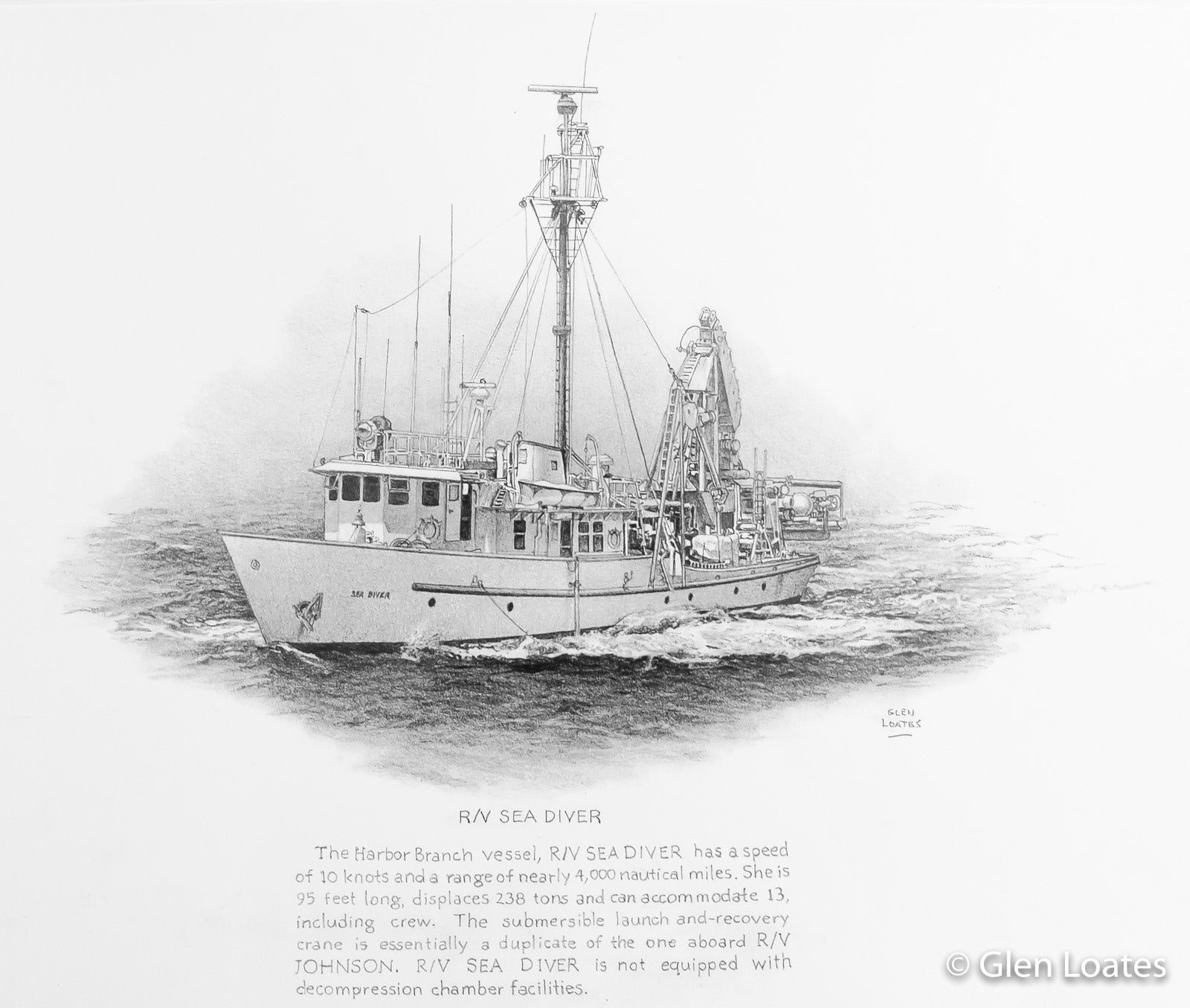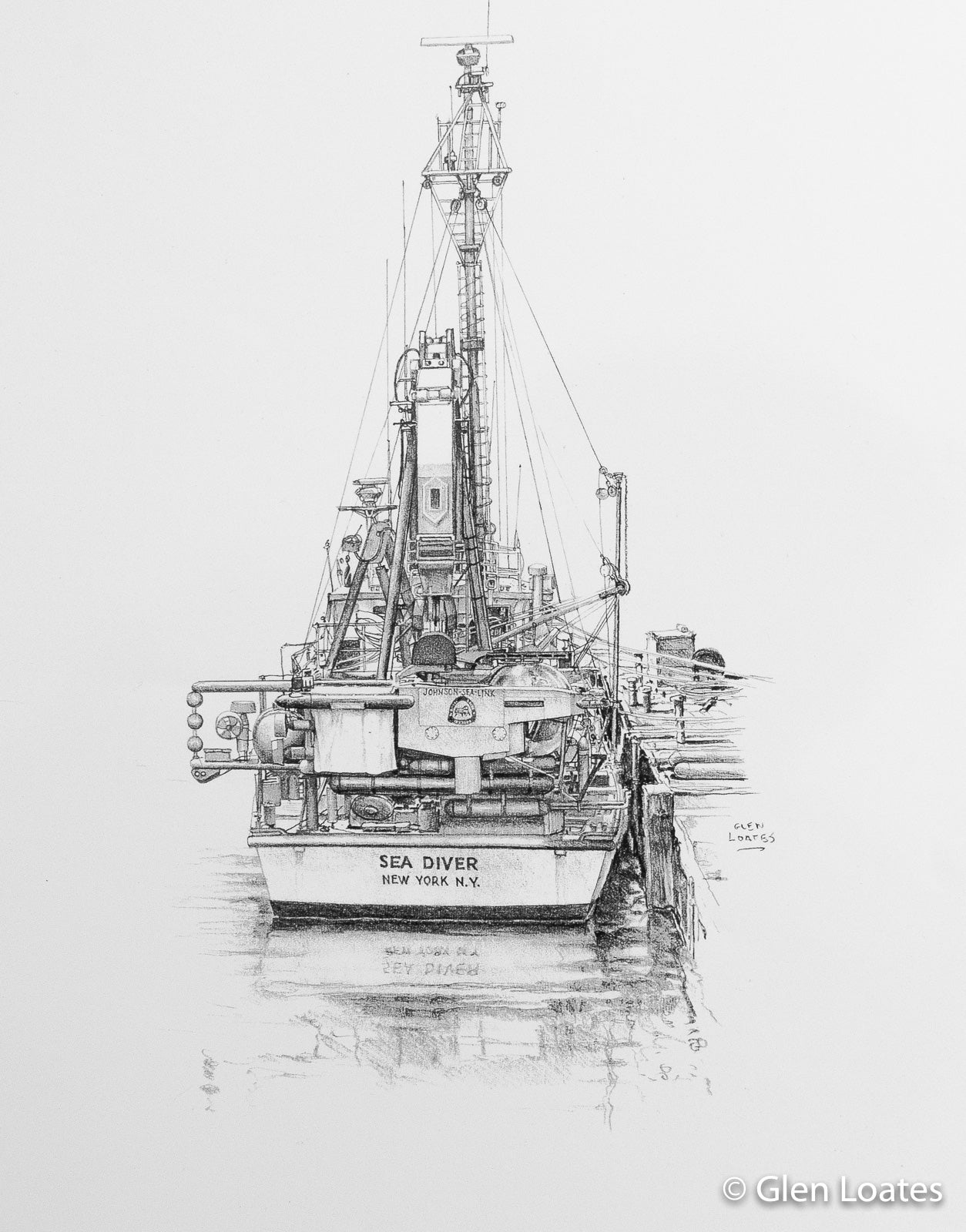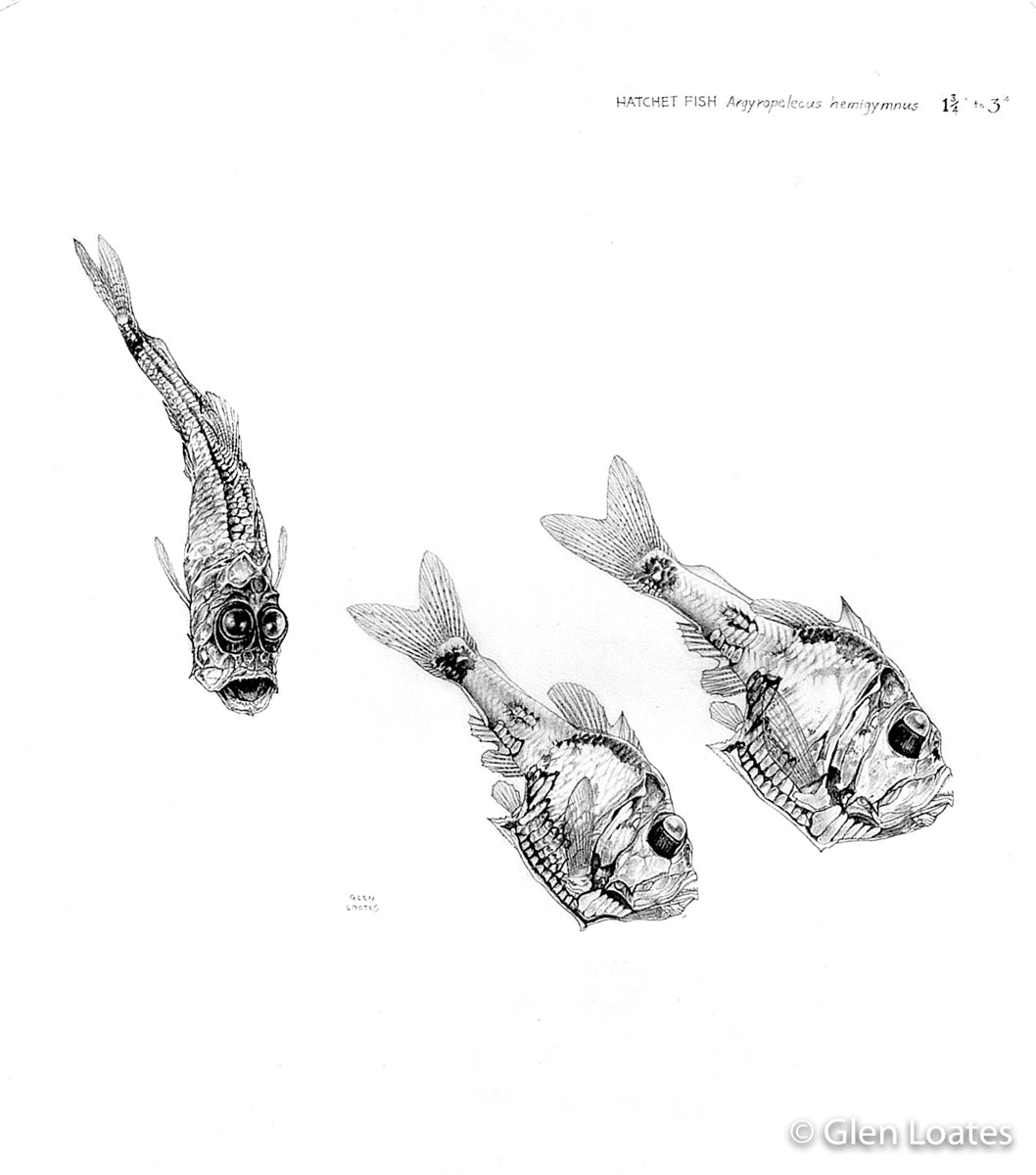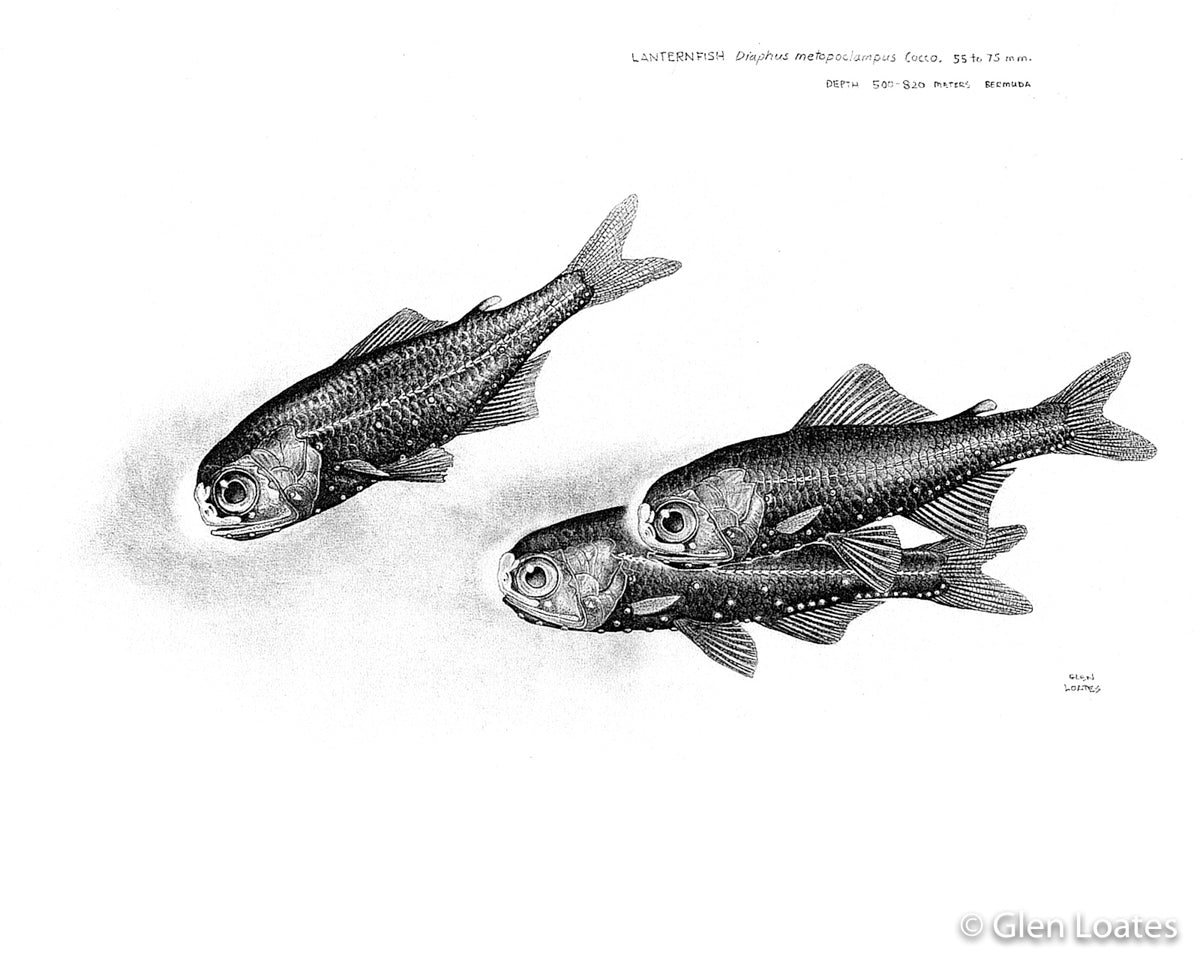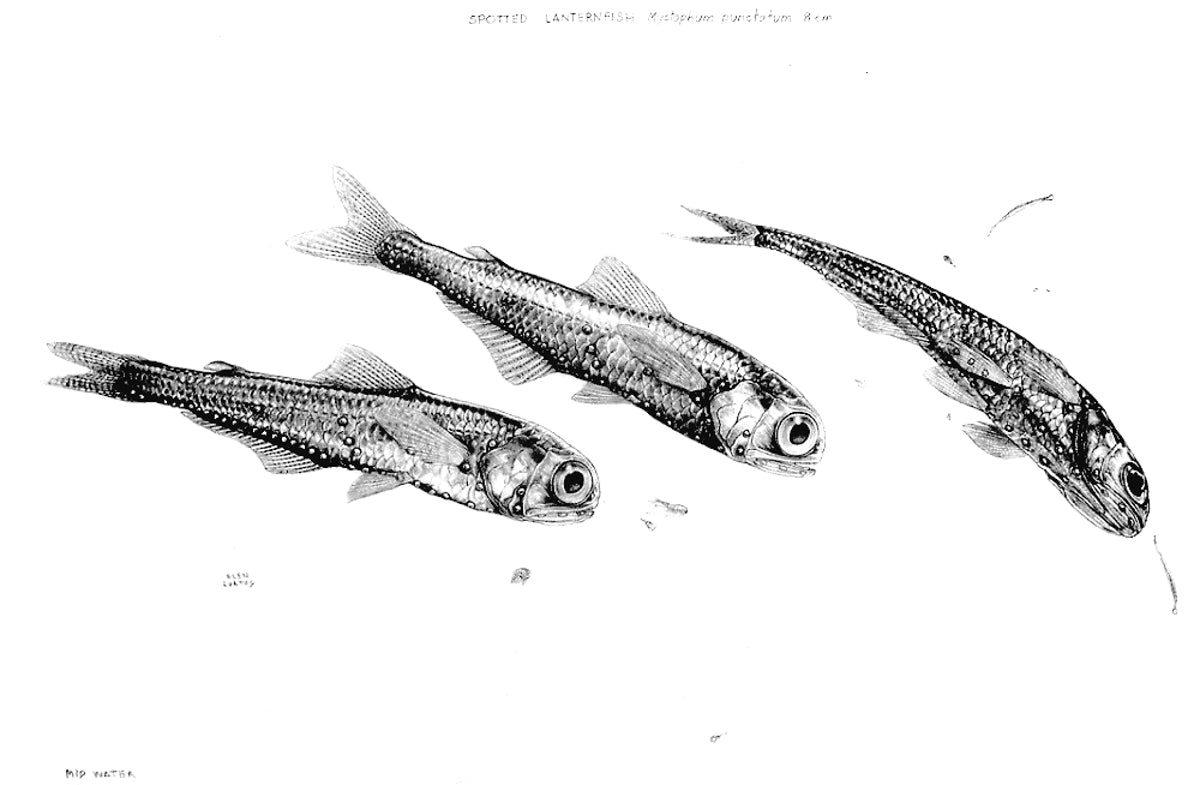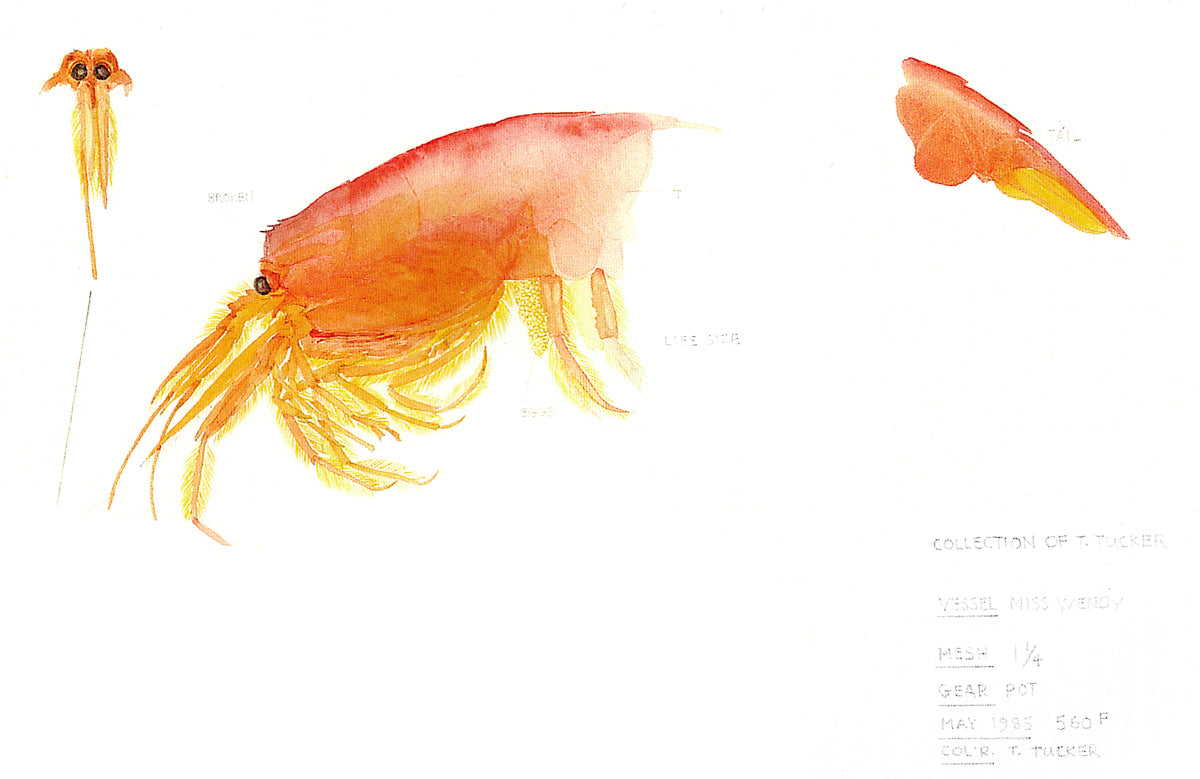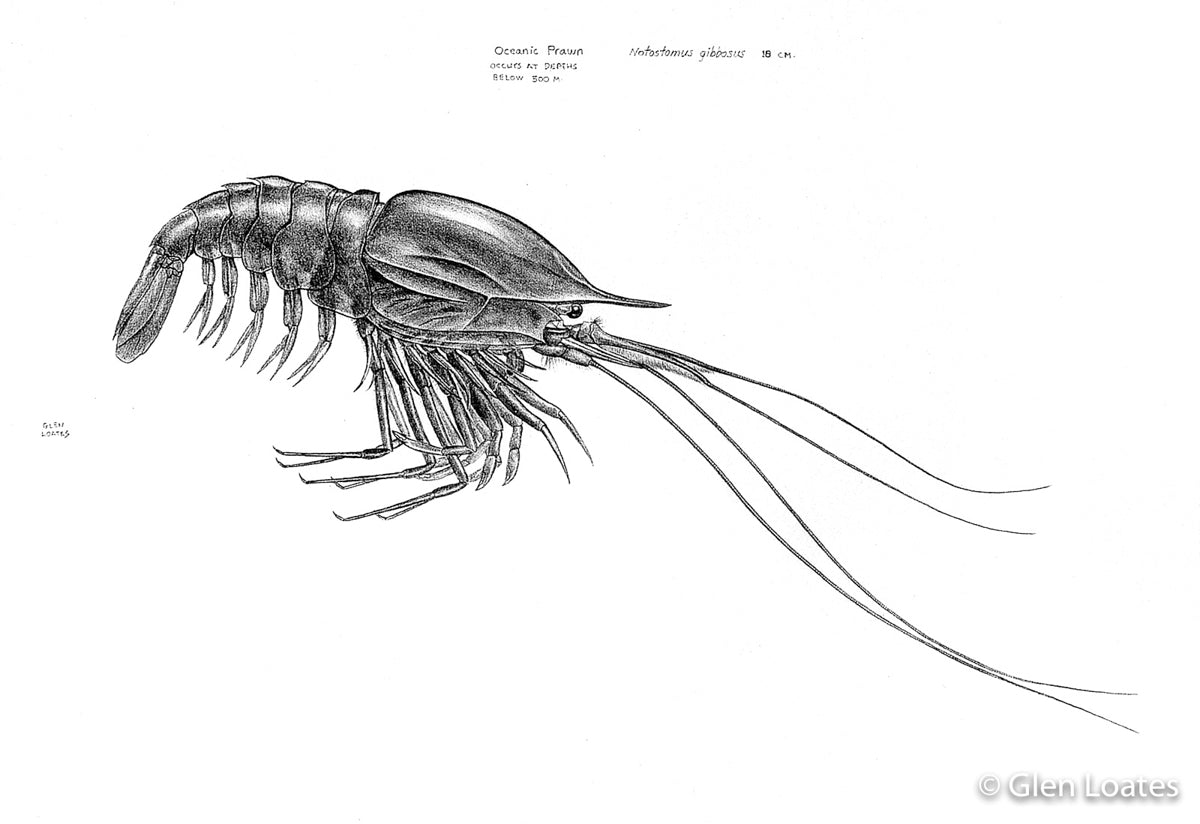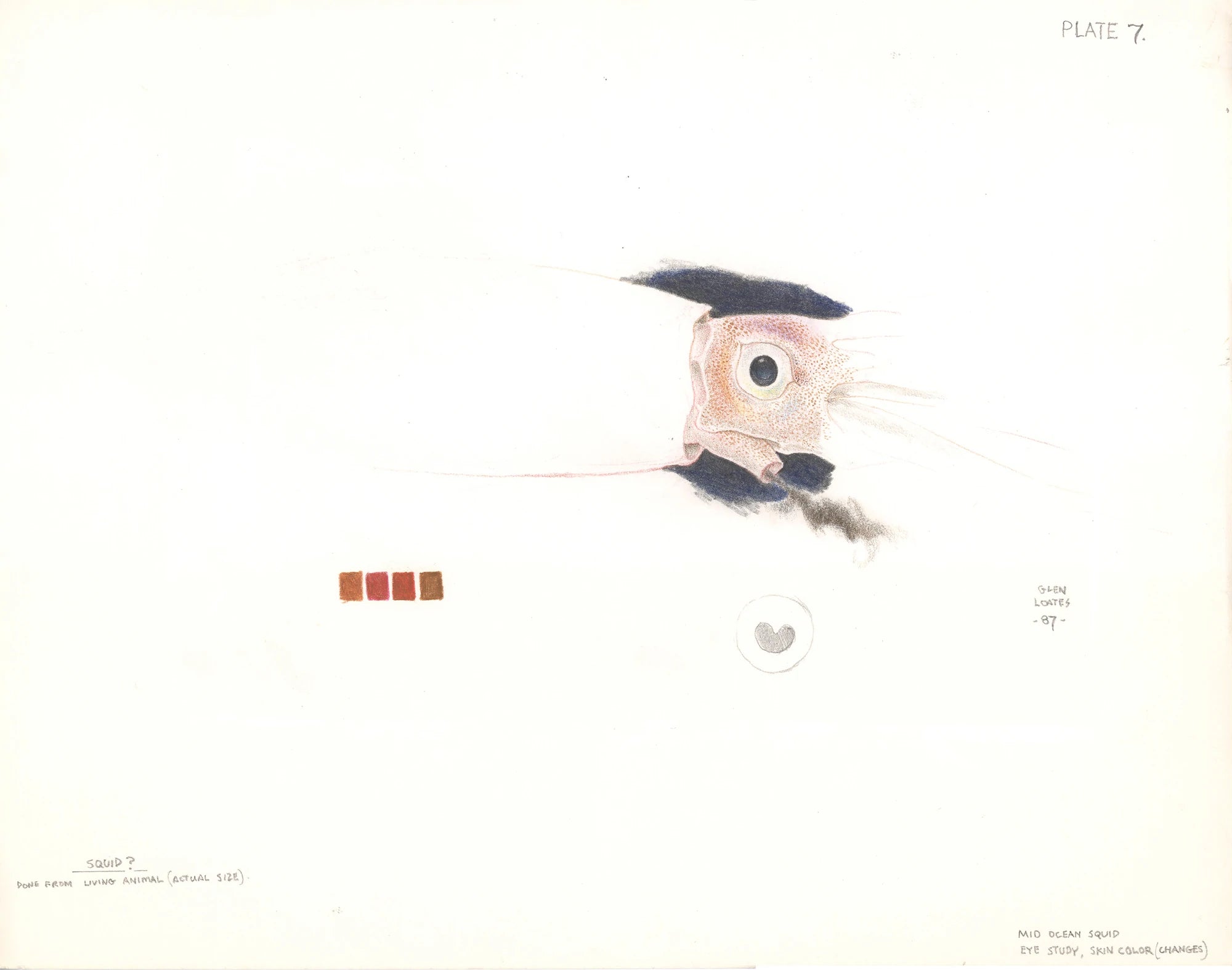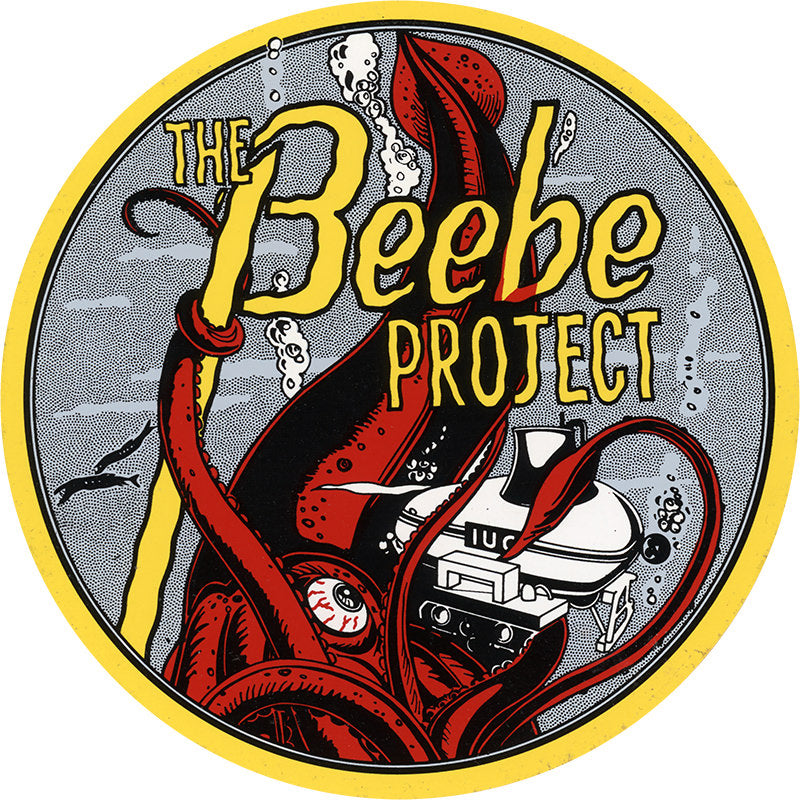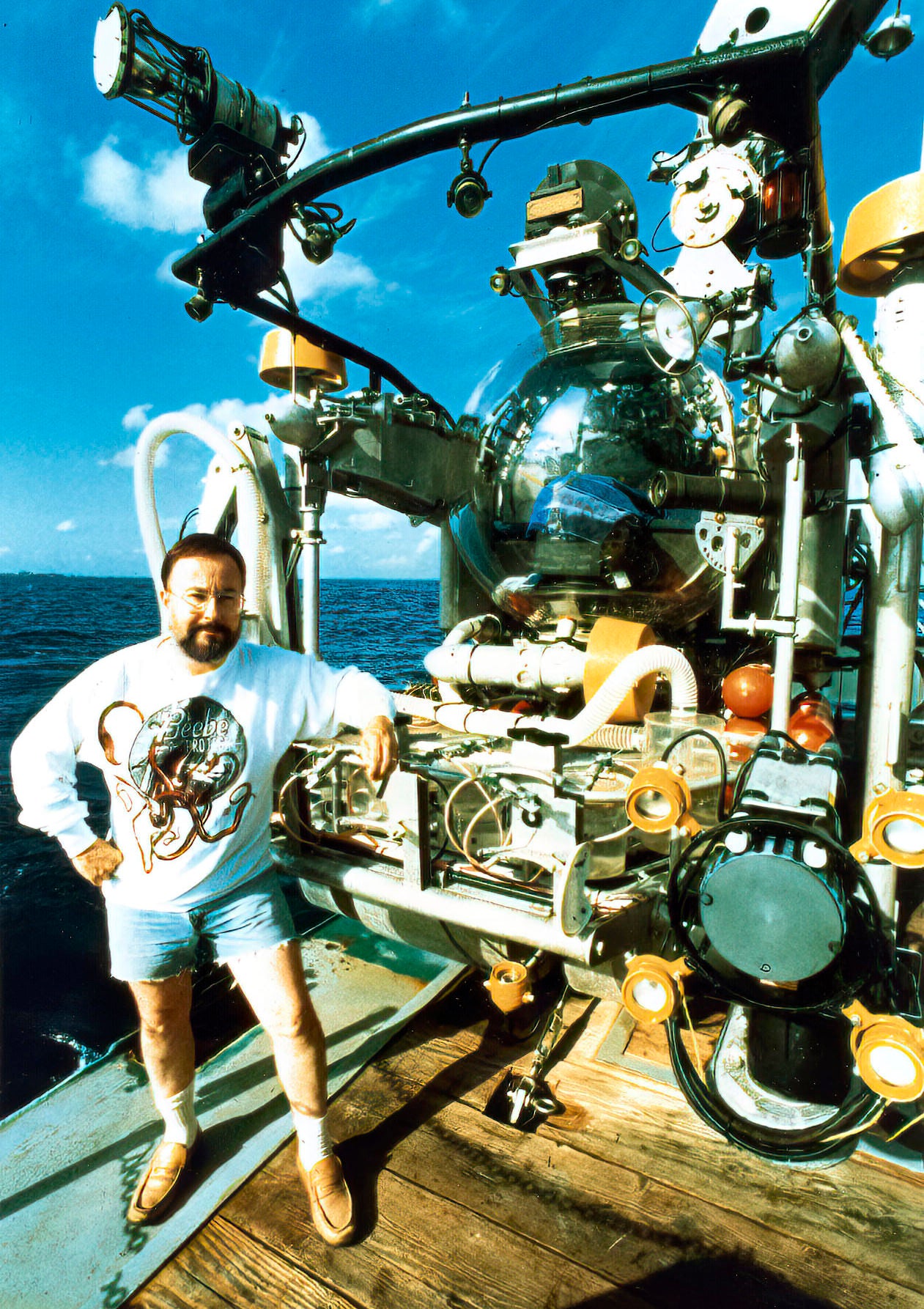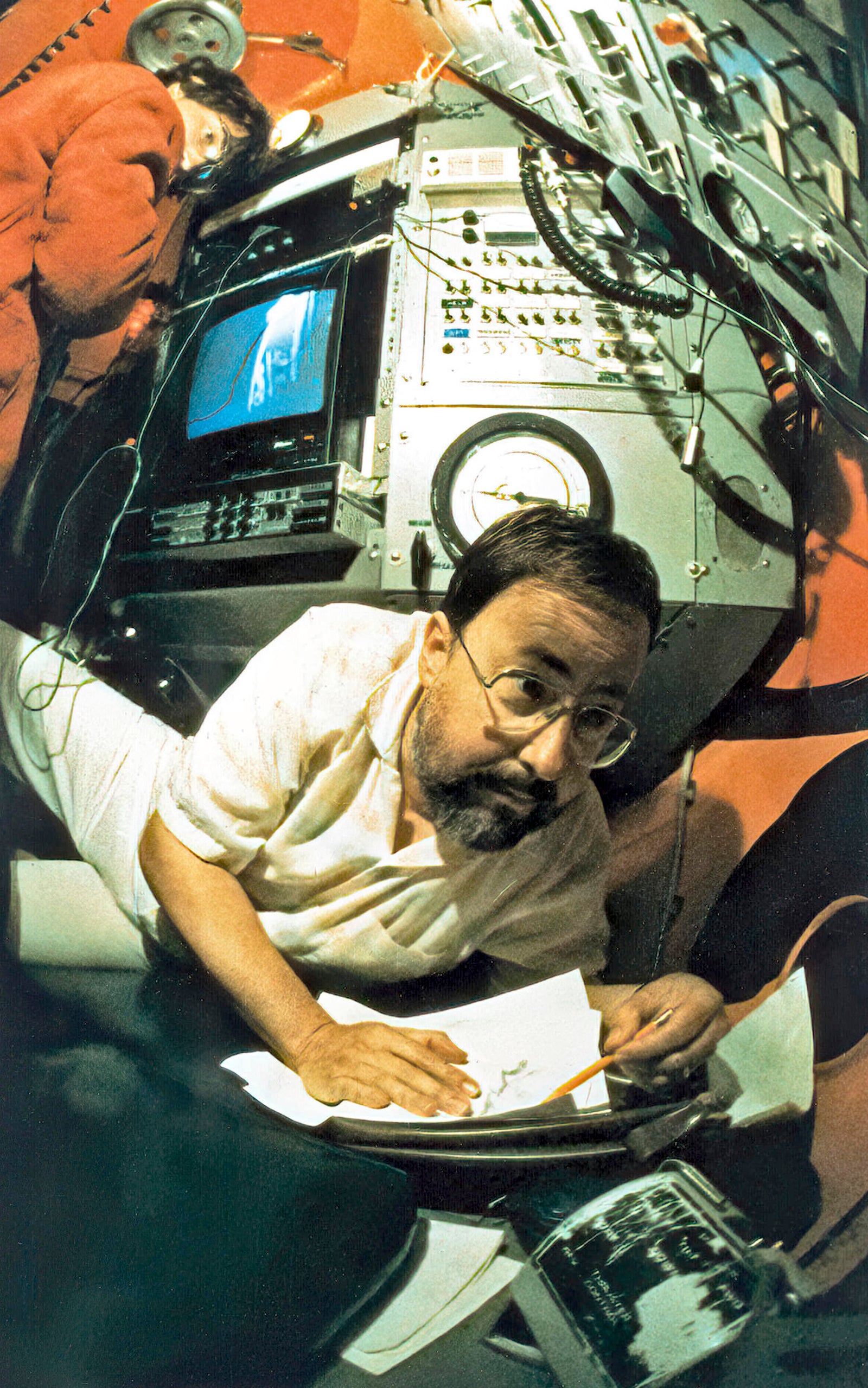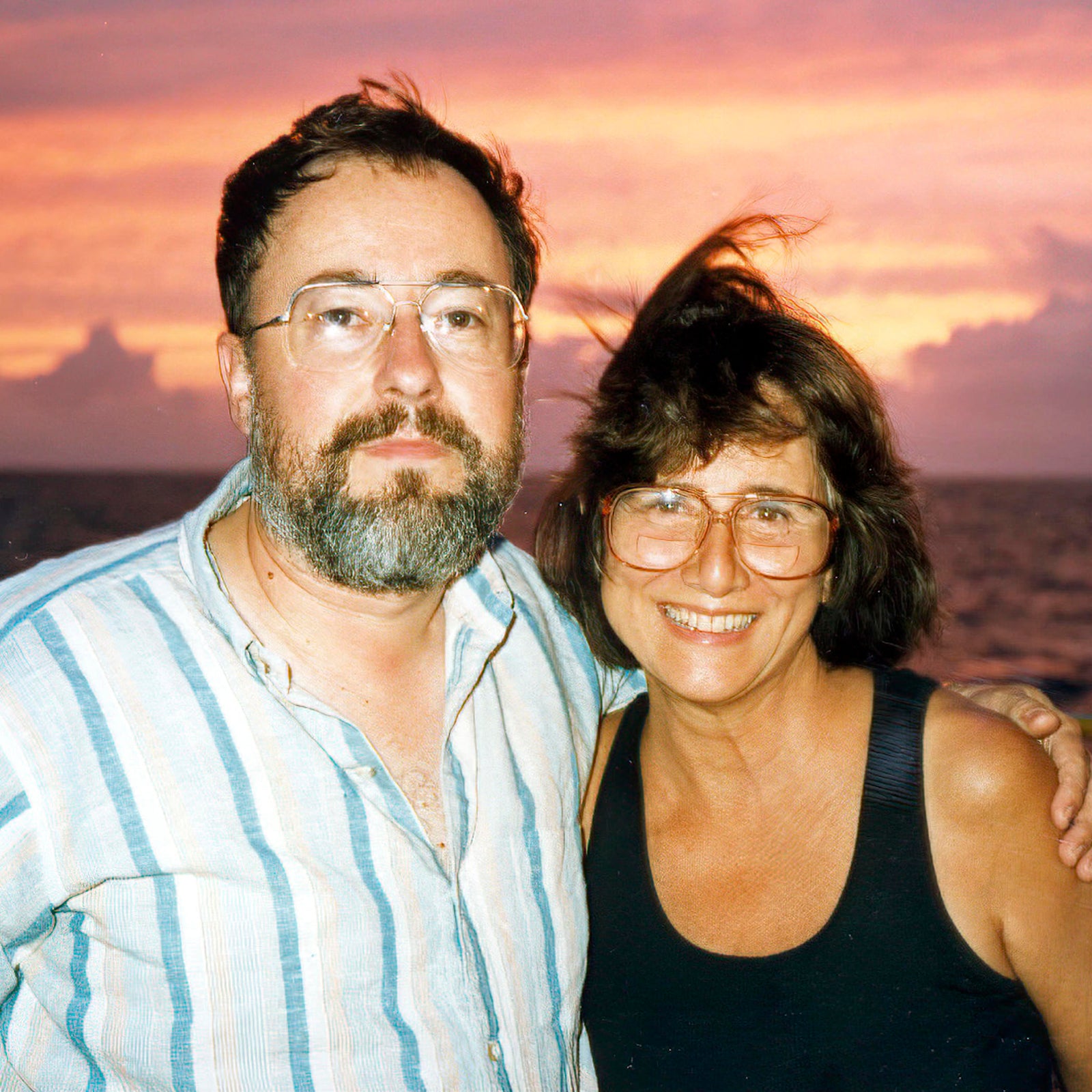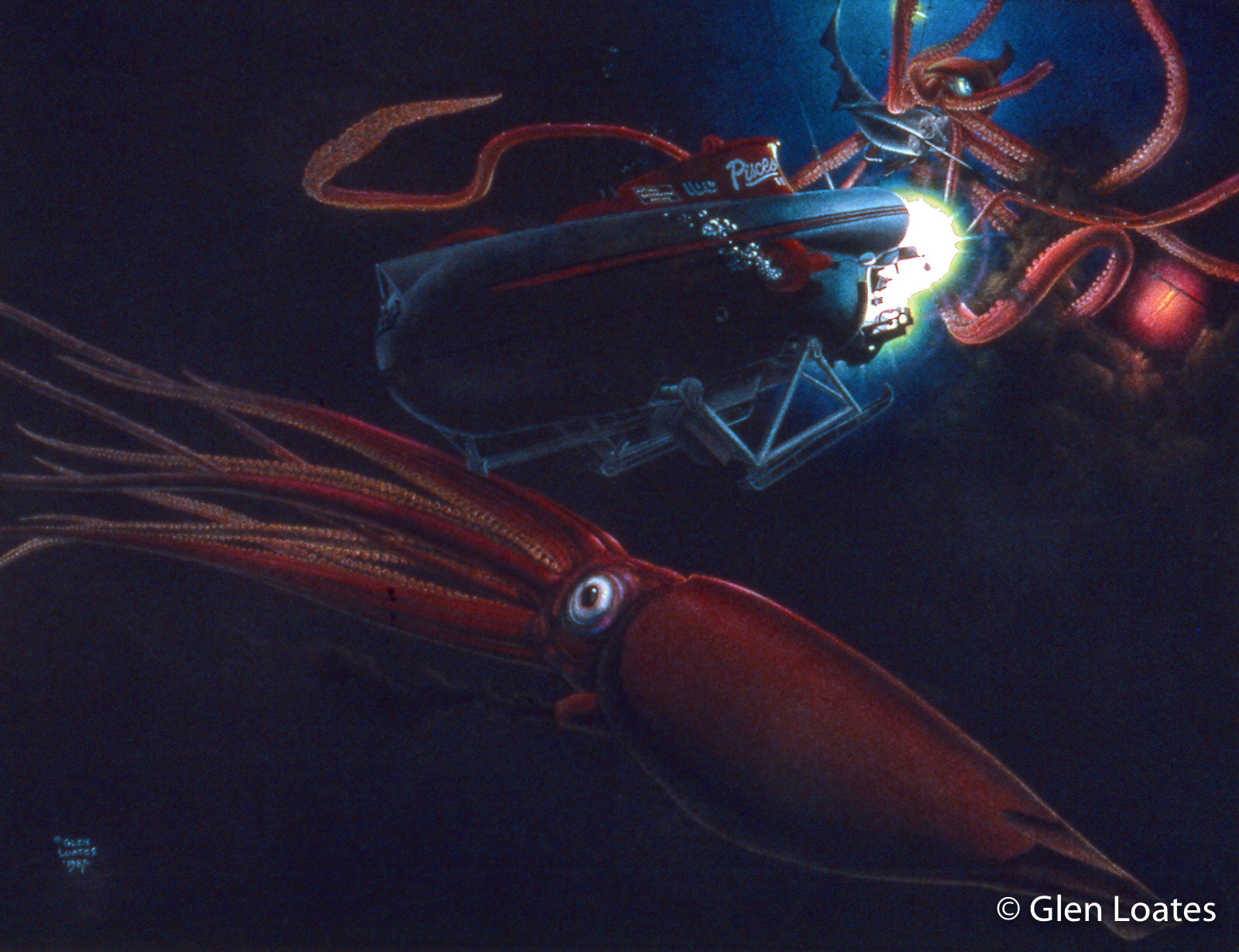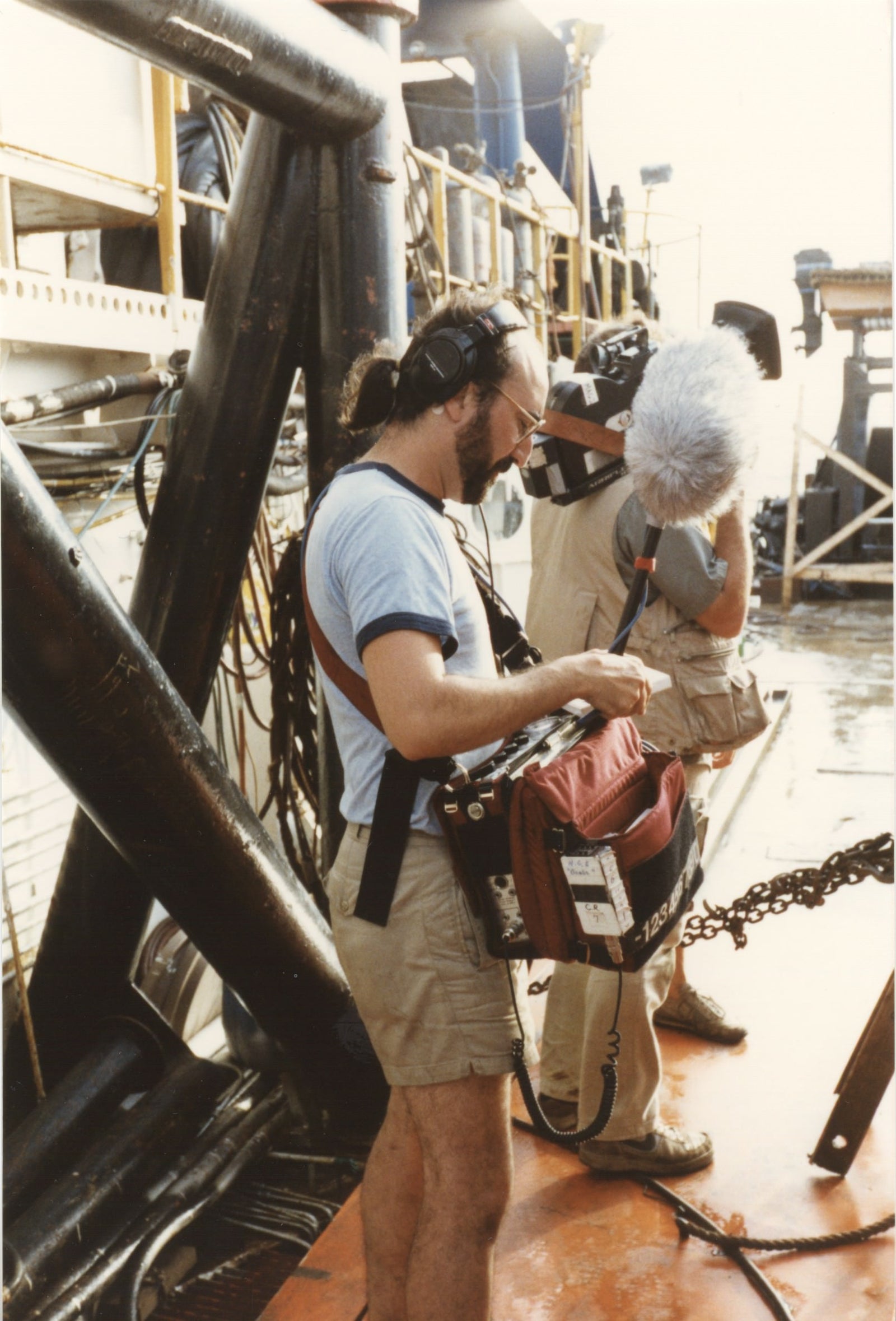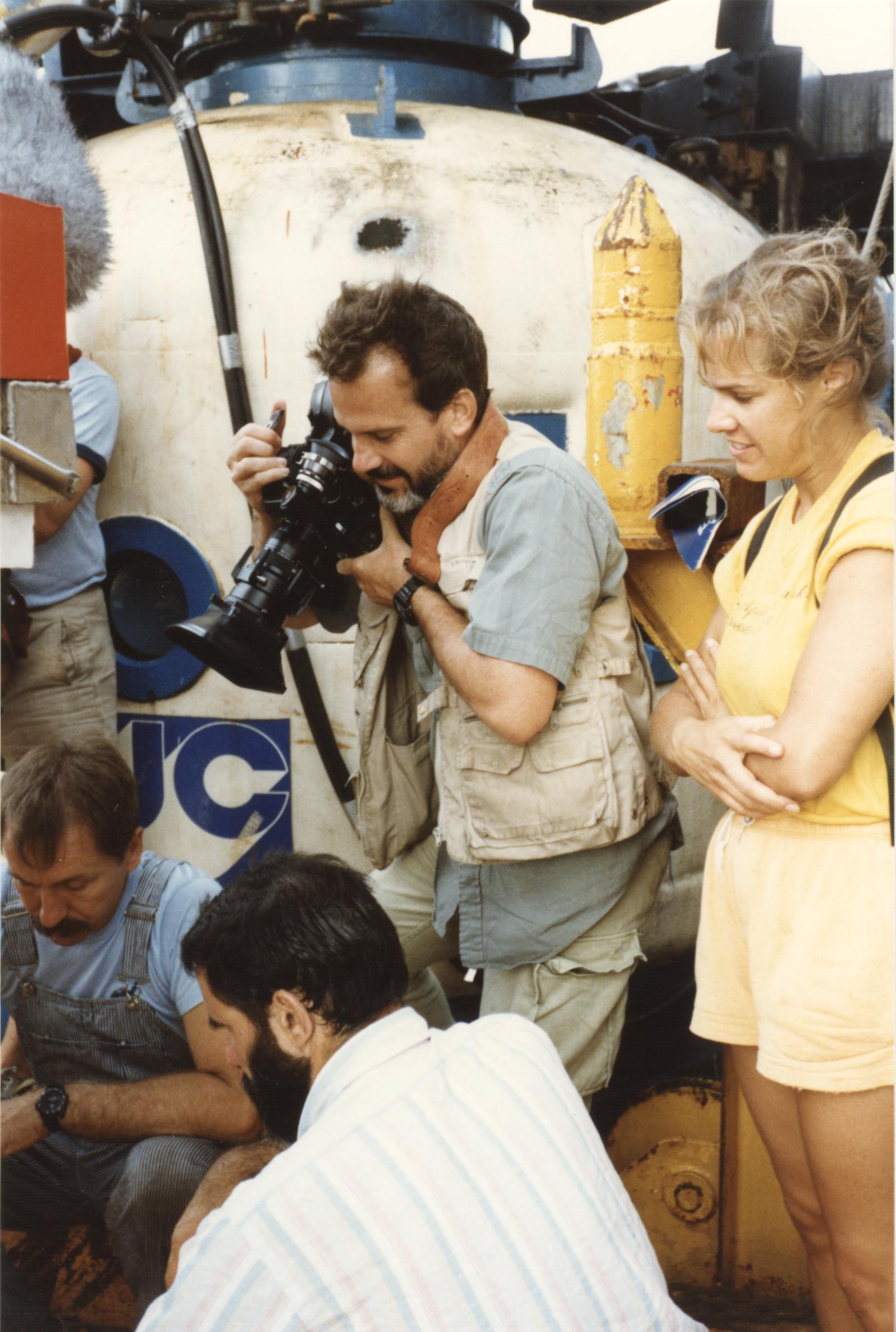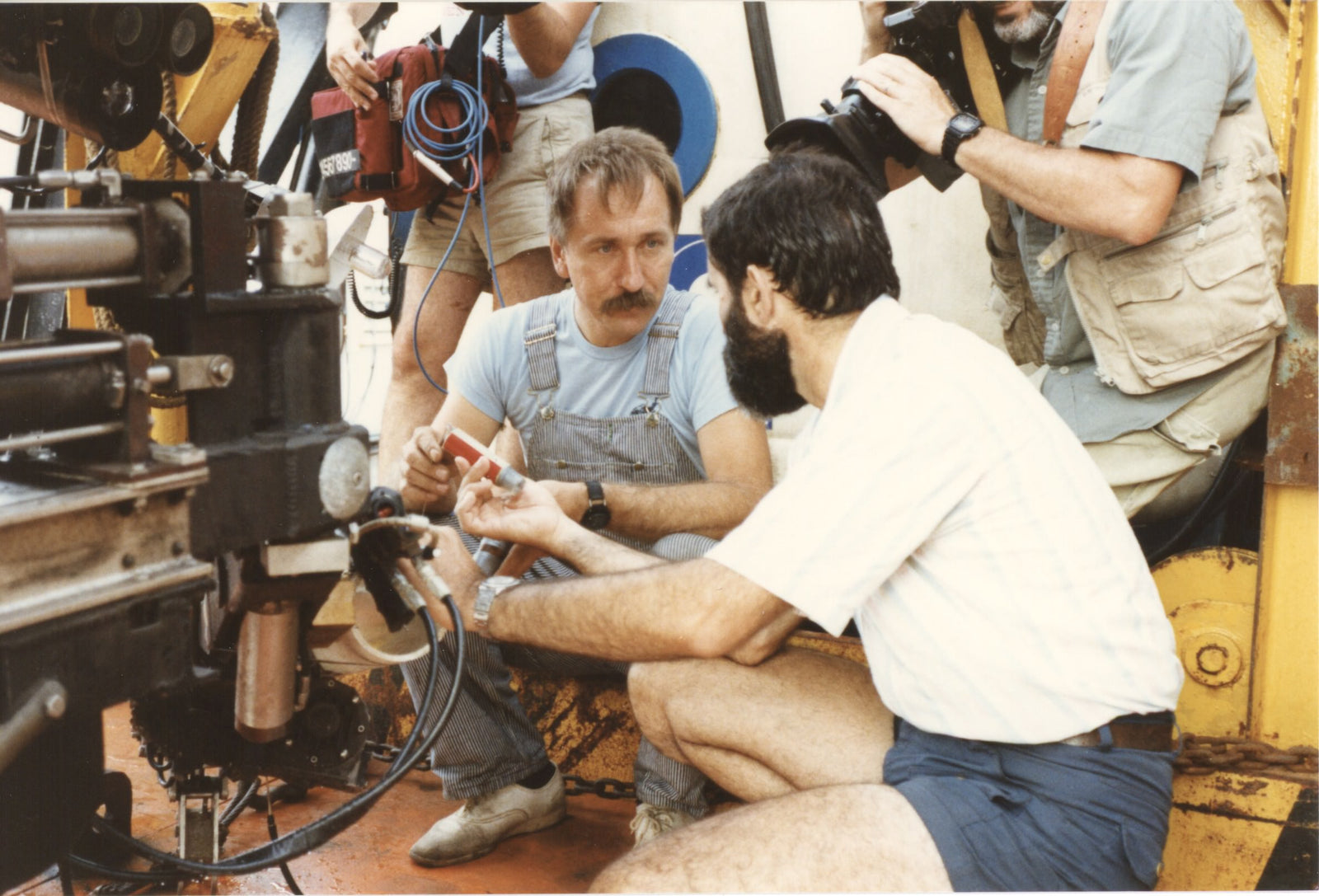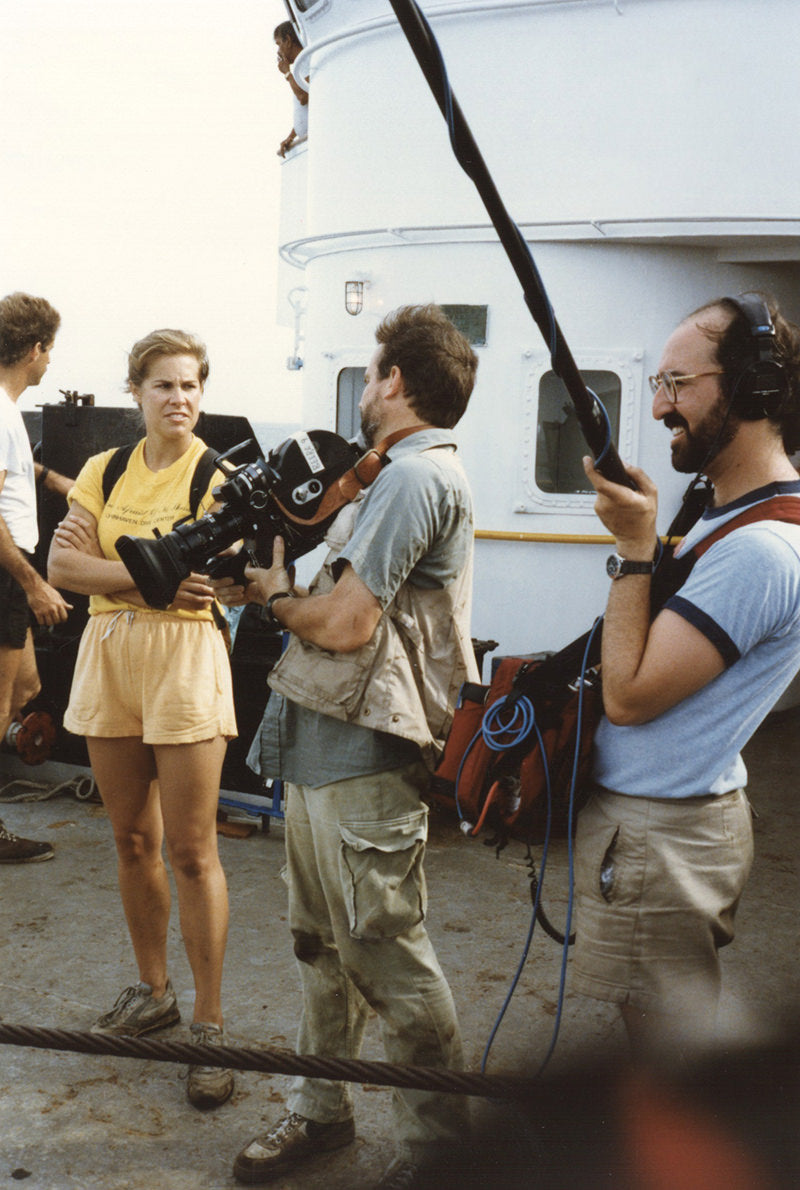In 1987, I embarked on my favorite expedition to date "The Beebe Project". I was the first artist in the world to be given this honour ."The Beebe Project" was the name given in honor of Dr. William Beebe who initiated deep-sea dives in 1934. Together with his technician/designer, Otis Barton, Dr. Beebe explored the sea 1/2 a mile down in his spherically shaped bathysphere.
BELOW PHOTO: Glen Loates beside the Johnson Sealink used for his first dive down 800 feet on The Beebe Project Expedition in 1986.
In 1987, I embarked on my favorite expedition to date "The Beebe Project". I was the first artist in the world to be given this honour ."The Beebe Project" was the name given in honor of Dr. William Beebe who initiated deep-sea dives in 1934. Together with his technician/designer, Otis Barton, Dr. Beebe explored the sea 1/2 a mile down in his spherically shaped bathysphere.
BELOW PHOTO: Glen Loates beside the Johnson Sealink used for his first dive down 800 feet on The Beebe Project Expedition in 1986.
I was invited as the chief scientific artist to accompany a team of top U.S. marine biologists and scientists to study deep-sea life in the Atlantic Ocean off the Bermuda coast. We made several dives in mini-submersibles, the Johnson Sea Link and the Pisces VI to descend 1 1/2 miles down to the ocean's floor. I was the first artist to have gone down this deep, exploring and witnessing first-hand what sea life is like down there. I am indebted to my long-time friend, Dr. Joseph MacInnis, the internationally known Canadian physician, explorer, marine scientist, and author. Emory Kristof, National Geographic Society photographer, organized and headed the expedition. The event was called the Beebe Project. It was the most spectacular, on-location field trip I have ever made. The ocean realm transported me to a world beyond my wildest dreams. I have been interested in the ocean ever since I read the Jules Verne novel, "20,000 Leagues Under the Sea" during the mid-50s. What seemed an impossible feat finally became a reality when I was invited to join the Beebe Project.
I continue to paint deep-sea life. New fields of composition have opened up to me along with a new color palette and the awareness of what happens to animals in this environment. Everything takes place within this world's color, hues, and shades.
Most animal life glows in the deep ocean, within its resplendent watery domain. The fish emit color while simultaneously picking up hues from their aquatic surroundings. This bioluminescence is a device for luring other fish within striking distance.
Since there exists such a vast difference between colors viewed on land and those seen under the ocean, I created a color chart graded by depth, to depict these underwater colors as accurately as possible.
BELOW PHOTO: Glen Loates sketching deep sea life, looking out the porthole in the Pisces VI.
I was invited as the chief scientific artist to accompany a team of top U.S. marine biologists and scientists to study deep-sea life in the Atlantic Ocean off the Bermuda coast. We made several dives in mini-submersibles, the Johnson Sea Link and the Pisces VI to descend 1 1/2 miles down to the ocean's floor. I was the first artist to have gone down this deep, exploring and witnessing first-hand what sea life is like down there. I am indebted to my long-time friend, Dr. Joseph MacInnis, the internationally known Canadian physician, explorer, marine scientist, and author. Emory Kristof, National Geographic Society photographer, organized and headed the expedition. The event was called the Beebe Project. It was the most spectacular, on-location field trip I have ever made. The ocean realm transported me to a world beyond my wildest dreams. I have been interested in the ocean ever since I read the Jules Verne novel, "20,000 Leagues Under the Sea" during the mid-50s. What seemed an impossible feat finally became a reality when I was invited to join the Beebe Project.
I continue to paint deep-sea life. New fields of composition have opened up to me along with a new color palette and the awareness of what happens to animals in this environment. Everything takes place within this world's color, hues, and shades.
Most animal life glows in the deep ocean, within its resplendent watery domain. The fish emit color while simultaneously picking up hues from their aquatic surroundings. This bioluminescence is a device for luring other fish within striking distance.
Since there exists such a vast difference between colors viewed on land and those seen under the ocean, I created a color chart graded by depth, to depict these underwater colors as accurately as possible.
BELOW PHOTO: Glen Loates sketching deep sea life, looking out the porthole in the Pisces VI.
My first dive was almost 5,117 fsw, exactly where Dr. Beebe and Otis Barton had been in the bathysphere, off the coast Nonsuch Island. I looked out of the porthole in the submersible at a world so awe-inspiring that I forgot my anxieties. It must be a lot like what an astronaut experiences in outer space-the blackness and the stars. One gets completely caught up in it. The realization that I was the first artist to see such creatures and such sights was so overwhelming I soon forgot that we were on our own down there, with no cable and no possibility of being rescued.
It took us about 3 hours to reach the bottom of the ocean. Then we spent 7 hours on the ocean floor and another 3 hours were needed to return to the surface.
Inside the Pisces VI, the temperature dropped to 5.6 degrees Celsius or 42 degrees Fahrenheit. The walls dampened and creaked as we descended. I was frightened, wet, and cold. I had to give up working with watercolors and use pencils instead. The crew and I had nothing to eat or drink for 24 hours before the dive since there were no toilet facilities aboard the submersible.
Halfway down, I could see the streamers of light being emitted from serpent dragon fish as they streaked past. Prawns, squid, and jellyfish were everywhere. Some of the faster-moving creatures would dart this way and that, creating beautiful swirling patterns of light. Other smaller animals, like plankton, arthropods, and arthropods, would float around looking like pulsating stars in the contrasting blackness. It was an artist's dream!
BELOW PHOTO: Glen Loates with shark specialist Eugenie Clark on-board the Twindrill ship
My first dive was almost 5,117 fsw, exactly where Dr. Beebe and Otis Barton had been in the bathysphere, off the coast Nonsuch Island. I looked out of the porthole in the submersible at a world so awe-inspiring that I forgot my anxieties. It must be a lot like what an astronaut experiences in outer space-the blackness and the stars. One gets completely caught up in it. The realization that I was the first artist to see such creatures and such sights was so overwhelming I soon forgot that we were on our own down there, with no cable and no possibility of being rescued.
It took us about 3 hours to reach the bottom of the ocean. Then we spent 7 hours on the ocean floor and another 3 hours were needed to return to the surface.
Inside the Pisces VI, the temperature dropped to 5.6 degrees Celsius or 42 degrees Fahrenheit. The walls dampened and creaked as we descended. I was frightened, wet, and cold. I had to give up working with watercolors and use pencils instead. The crew and I had nothing to eat or drink for 24 hours before the dive since there were no toilet facilities aboard the submersible.
Halfway down, I could see the streamers of light being emitted from serpent dragon fish as they streaked past. Prawns, squid, and jellyfish were everywhere. Some of the faster-moving creatures would dart this way and that, creating beautiful swirling patterns of light. Other smaller animals, like plankton, arthropods, and arthropods, would float around looking like pulsating stars in the contrasting blackness. It was an artist's dream!
BELOW PHOTO: Glen Loates with shark specialist Eugenie Clark on-board the Twindrill ship
We came to rest on a shelf 4,000 feet down and continued to descend later after having studied the creatures at that level. Dr. Eugenie Clark, one of the marine scientists, wanted to learn more about six-gilled sharks at this depth. She arranged to have metal cages baited with pieces of tuna to attract these massive sharks and other creatures. The bright thallium iodide lights were turned off. Then we waited. Suddenly, the big fish arrived. Trying to get at the food inside, they attacked the bait traps thrashing this way and that, stirring up the silt into menacing dark clouds.
Then the harsh lights were turned on. The smaller fish scurried to flee this brilliance they had never experienced before. Out from beyond this light, I noticed something coming into view. It was a large species of shark, the six-gilled shark that Dr. Clark had wanted to see. Slowly moving in towards the bait traps, it terrified all the other creatures causing them to dart away. It was over twenty feet long. This enormous "eating-machine," one of the most effective predators on the planet, crashed up against the sub, knocking us over. I could not see the entire shark as it slowly moved by my viewing window as it investigate us. It was just too vast.
I continued to sketch feverishly, trying to get it all down, while Emory Kristof and the sub's pilot recorded it on film. I have been on several other dives and locations over the years, but have never seen the giant squid. The expeditions are continuing, and sometime soon, I hope my dream of seeing this elusive animal will become a reality. With technological advances, we now have the equipment to explore the ocean at greater depths.
I gained from the Beebe project what an artist needs most: inspiration, and the desire to create.
We came to rest on a shelf 4,000 feet down and continued to descend later after having studied the creatures at that level. Dr. Eugenie Clark, one of the marine scientists, wanted to learn more about six-gilled sharks at this depth. She arranged to have metal cages baited with pieces of tuna to attract these massive sharks and other creatures. The bright thallium iodide lights were turned off. Then we waited. Suddenly, the big fish arrived. Trying to get at the food inside, they attacked the bait traps thrashing this way and that, stirring up the silt into menacing dark clouds.
Then the harsh lights were turned on. The smaller fish scurried to flee this brilliance they had never experienced before. Out from beyond this light, I noticed something coming into view. It was a large species of shark, the six-gilled shark that Dr. Clark had wanted to see. Slowly moving in towards the bait traps, it terrified all the other creatures causing them to dart away. It was over twenty feet long. This enormous "eating-machine," one of the most effective predators on the planet, crashed up against the sub, knocking us over. I could not see the entire shark as it slowly moved by my viewing window as it investigate us. It was just too vast.
I continued to sketch feverishly, trying to get it all down, while Emory Kristof and the sub's pilot recorded it on film. I have been on several other dives and locations over the years, but have never seen the giant squid. The expeditions are continuing, and sometime soon, I hope my dream of seeing this elusive animal will become a reality. With technological advances, we now have the equipment to explore the ocean at greater depths.
I gained from the Beebe project what an artist needs most: inspiration, and the desire to create.
It was an honor to present this painting to my good friend, Emory Kristof who led this expedition and organized everything with National Geographic. We produced limited edition prints in order to raise funds and create awareness.
It was an honor to present this painting to my good friend, Emory Kristof who led this expedition and organized everything with National Geographic. We produced limited edition prints in order to raise funds and create awareness.
National Geographic accompanied us on the Beebe Project Expedition.
National Geographic accompanied us on the Beebe Project Expedition.
